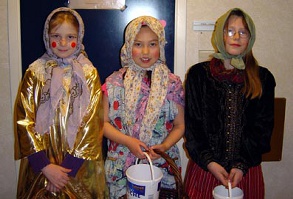|
|








Easter hags
Interestingly, Easter is Sweden’s nearest equivalent to the American Halloween. It’s a strange meld of the Christian Easter and the pagan rites of the vernal equinox.
First, a reminder of the origins of Halloween
In the pre-Christian European cultures, the equinoxes (in spring and fall, the two days when the day and night are exactly the same length) and the solstices (in summer and winter, when the difference is greatest between hours of daylight and darkness) were significant supernatural days of the year and had their own special festivals. In Celtic tradition, the autumnal equinox,
Interestingly, Easter is Sweden’s nearest equivalent to the American Halloween. It’s a strange meld of the Christian Easter and the pagan rites of the vernal equinox.
First, a reminder of the origins of Halloween
In the pre-Christian European cultures, the equinoxes (in spring and fall, the two days when the day and night are exactly the same length) and the solstices (in summer and winter, when the difference is greatest between hours of daylight and darkness) were significant supernatural days of the year and had their own special festivals. In Celtic tradition, the autumnal equinox,
Samhain, was the biggest holiday of the year, because it
combined a celebration of the harvest with the magical
equinox when the spirit world and the world of the living
overlapped. That made it a festival for everyone, living or dead.
As the Roman Empire spread across Europe, they found that a good way to get conquered people to convert was to adopt the major festival of the conquered people and give it a Christian meaning. However, when they reached the northern countries, the Romans were horrified by the idea of the dead walking. They created All Hallows Day to appease the spirits and keep them in their graves. A tragic mangling of the original concept.
It soon became a tradition that if you had to be out on All Hallows Eve, you were supposed to dress as something scary—either to fit in with the ghosts or to scare the wandering souls into keeping their distance. And if spooks showed up on your doorstep, you gave them what they wanted to make them go away.
combined a celebration of the harvest with the magical
equinox when the spirit world and the world of the living
overlapped. That made it a festival for everyone, living or dead.
As the Roman Empire spread across Europe, they found that a good way to get conquered people to convert was to adopt the major festival of the conquered people and give it a Christian meaning. However, when they reached the northern countries, the Romans were horrified by the idea of the dead walking. They created All Hallows Day to appease the spirits and keep them in their graves. A tragic mangling of the original concept.
It soon became a tradition that if you had to be out on All Hallows Eve, you were supposed to dress as something scary—either to fit in with the ghosts or to scare the wandering souls into keeping their distance. And if spooks showed up on your doorstep, you gave them what they wanted to make them go away.
Swedish Easter hags
In Scandinavian mythology, the vernal
(spring) equinox is when the witches of
the earth had their annual coven. People
built bonfires and lit firecrackers to scare
the witches away. If an old hag came to
your door begging for food or money, it
was best to give it to her in case she was
a witch who might cast a spell on you.
When Christianity arrived in Sweden, the
equinox–witch tradition gradually shifted
to Easter, the only major Christian holiday
that is actually based on the equinox instead
of the calendar (it’s the first Sunday after the
first full moon after the equinox).
As with Halloween, as people grew less superstitious, the idea of dressing as a witch and knocking on doors looking for handouts became a childish prank and later a childhood tradition.
In Scandinavian mythology, the vernal
(spring) equinox is when the witches of
the earth had their annual coven. People
built bonfires and lit firecrackers to scare
the witches away. If an old hag came to
your door begging for food or money, it
was best to give it to her in case she was
a witch who might cast a spell on you.
When Christianity arrived in Sweden, the
equinox–witch tradition gradually shifted
to Easter, the only major Christian holiday
that is actually based on the equinox instead
of the calendar (it’s the first Sunday after the
first full moon after the equinox).
As with Halloween, as people grew less superstitious, the idea of dressing as a witch and knocking on doors looking for handouts became a childish prank and later a childhood tradition.
Anna, Amanda and Maja as Easter hags
Swedish phenomena
- Red houses
- Signs
- Winter darkness
- Feathersticks
- Easter hags
- Going Postal
Funny stories
- “Is that in Europe?”
- The Good Ship Vasa
- The openness principle
- Red houses
- Signs
- Winter darkness
- Feathersticks
- Easter hags
- Going Postal
Funny stories
- “Is that in Europe?”
- The Good Ship Vasa
- The openness principle



